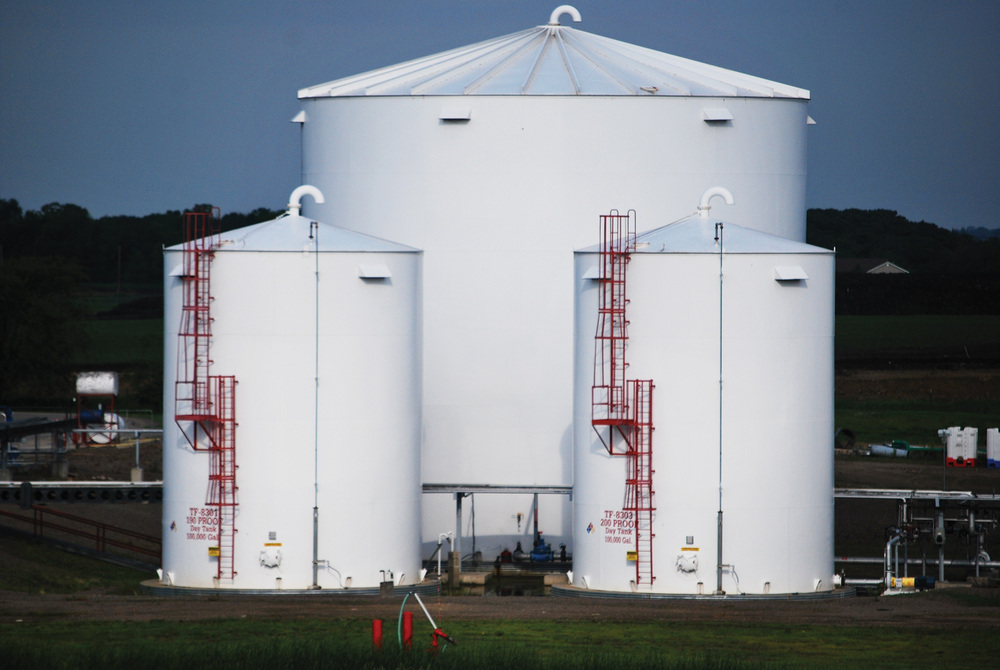Ethanol Tanks—Have They Been Inspected Lately?



BBI INTERNATIONAL, Sue Retka Schill
March 29, 2013
BY Erika Henderson
As the ethanol industry matures, new ethanol tanks are being constructed daily, but concerns are growing about older tanks, particularly those constructed in the early years of the ethanol build-out. Most have not been inspected regularly, and some have never been inspected.
Knowledge must continue to grow and develop to help prolong the life of these tanks. The American Petroleum Institute provides standards for the safe storage of petroleum products in API 650, 651 and 653. These standards, designed to protect employees, the public and the environment, are the tank owner’s responsibility to implement. Tank inspections will help with obtaining accurate information needed for constructing, repairing and prolonging the life span of tanks in the ethanol industry.
Before inspection, it is important to know the characteristics of the product stored to avoid serious injury or even death. A good place to start is with the material safety data sheets. Ethanol for example, reacts violently and explodes with several products. It is incompatible with platinum and sodium, and cannot be mixed or stored with certain fuels. Proper precautions must be taken when inspecting a tank with potentially explosive and hazardous contents. This is why it is so important to have a reputable company perform the inspections, one that is committed to the proper training in safety and first aid. Medical evaluations, pulmonary function and respirator fit tests must be performed on employees before entering the tanks. It is also important for tank owners to have a properly equipped and trained rescue team available that is no more than 15 minutes away.
Inspection List
Several features of an ethanol tank need to be inspected regularly, and a written report should be provided to the owner after the inspection. The report should include a detailed evaluation with photographs, recommendations of needed and emergency repairs, code updates and a detailed cost estimate for each item. All aspects of the tank should be inspected for structural, safety and coating conditions in accordance with API standards. Vents, screens, manways, overflows, ladders and drain valves should also be inspected to prevent unauthorized access. The tank foundation, soil and settlement conditions should be monitored. Any tank distortions and all operating conditions such as filling and emptying rates need to be noted. All visual maintenance checks should be documented along with corrosion monitoring and the leak detection system used, which can include double-bottom liners or liners under tank bottoms with leak-detection pipes. The type of cathodic protection, stress levels and ultrasonic thickness (UT) readings from previous inspections can help access present conditions.
Advertisement
Advertisement
Other documents obtained during construction should remain with the tank owner for the life of the tank, including tank design, loadings, metal characteristics, weld testing and location of the tank. Such information provides the inspector with a complete picture to assess the life of the tank.
Levels of Inspection
Three main types of inspections should be performed regularly. Routine in-service inspections can be performed by a facility employee on a frequent and routine basis. With a check sheet in hand, each part of the tank should be visibly inspected, the general foundation condition should be noted along with any signs of settlement and any evidence of leaks, corrosion or damage should be listed and reported. Drains, secondary containment, plates, shell, roof, nozzles, attachments, ladders stairs and platforms should all be inspected and the overall condition of the tank noted. These routine in-service inspections help determine the scope of the formal inspections.
The second type is a formal external in-service inspection that should be performed by an authorized inspector at least every five years, as stated in API 653 6.3.2. The checklist includes looking for corrosion, distortions, leaks and damage. Corrosion can also occur under the insulation and on the underside of floor plates. Nozzles attached to the roof, shell and floor should also be included in this corrosion search. External UT measurements of the shell should be taken to help determine the integrity of the shell and a rate of corrosion. Creating a matrix chart to identify and record tests of specific areas can provide a more accurate picture than random testing.
Advertisement
Advertisement
The third type, a formal out-of-service internal inspection, requires draining and cleaning the tank to achieve a safe working environment for accurate readings. The internal visual inspection requires the inspector to do more extensive investigations for corrosion, erosion, thinning, cracking, and other damage that may have occurred to the tank. The floor of the tank is given a detailed inspection including UT floor readings.
A risk analysis may also need to be performed to decide tank inspection frequencies—even annual or biannual. The analysis considers the tank’s age and whether it has secondary containment or cathodic protection. Knowing the tank history and typical corrosion concerns will help decide the extent of UT data needed to accurately determine a safe timeline for inspections. A tank may be experiencing higher-than- normal corrosion rates, that often occur when a tank is not adequately protected or standing water and debris remains for an extended period. Tank bottoms are another area where deterioration is first spotted. Therefore, the structure and condition of bottoms must be monitored carefully to prevent the risk of leakage—a catastrophic environmental disaster and potentially great financial loss.
Inspections do require a significant amount of time and discipline to perform correctly. Some inventive companies are creating robots that may make inspections more efficient and less time consuming, while seeking to eliminate the need to drain the tank. Robots have been used for internal inspections of water tanks for years now, but robot designs that can safely withstand the hazardous conditions of an ethanol tank are just beginning to get under way.
Author: Erika Henderson
Director of Research
Pittsburg Tank & Tower
270-826-9000
sales@watertank.com
The claims and statements made in this article belong exclusively to the author(s) and do not necessarily reflect the views of Ethanol Producer Magazine or its advertisers. All questions pertaining to this article should be directed to the author(s).
Related Stories
The European Commission on July 18 announced its investigation into biodiesel imports from China is now complete and did not confirm the existence of fraud. The commission will take action, however, to address some systemic weaknesses it identified.
Kintetsu World Express Inc. has signed an additional agreement with Hong Kong, China-based Cathay Pacific Airways for the use of sustainable aviation fuel (SAF). The agreement expands a three-year partnership between the two companies.
Broco Energy on July 17 announced a new partnership with the Massachusetts Port Authority (Massport) to deliver and transition Massport's fuel tanks to renewable diesel across its various facilities.
Shell Aviation, Accenture, and Amex GBT on July 10 announced Avelia is in the process of evolving to an industry solution with independent data hosting and a multi-supplier model helping users access the GHG benefits of SAF.
The U.S EPA on July 17 released data showing more than 1.9 billion RINs were generated under the RFS during June, down 11% when compared to the same month of last year. Total RIN generation for the first half of 2025 reached 11.17 billion.
Upcoming Events










